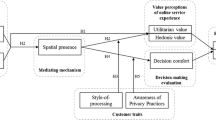Abstract
This study presents an experimentthat investigates how individuals perform anavigation test in a desktop virtualenvironment. The participants were randomlyassigned to one of the five test conditions:(C1) a map as information material during theentire test, (C2) the map only visible beforethe test, (C3) textual information during theentire test, (C4) textual information onlybefore the test and (C5) no additionalnavigational cues. The results were thatadditional information during the entire testwas more effective than short periods ofstudying the map or textual information onlybefore the test. However, participants weremore accurate in finding their route when anykind of navigational cues were used than whenno navigational cues were used. The results ofan additional questionnaire indicate thatbetween the test groups there were nodifferences in estimating the travelleddistances. The performance to draw the coveredpath into a sketch map of the landscape did notdiffer significantly between the test groupswith additional navigational cues. Theseresults indicate that in certain environmentstextual information may provide an effectivealternative to navigation training with a map.
Similar content being viewed by others
References
Albert, W.S., Rensink, R.A. and Beusmans, J.M. (1999).Learning Relative Directions Between Landmarks in a Desktop Virtual Environment, Spatial Cognition and Computation 1: 131–144.
Bliss, J.P., Tidwell, P.D. and Guest, M.A. (1997).The Effectiveness of Virtual Reality for Administering Spatial Navigation Training for Firefighters, Presence 6: 73–86.
Bowmann, D.A., Davis, E.T., Hodges, L.F. and Badre, A.N. (1999).Maintaining Spatial Orientation during Travel in an Immersive Virtual Environment, Presence 8(6): 618–631.
Bülthoff, H.H. and van Veen, H.A.H.C. (1999), Vision and Action in Virtual Environments: Modern Psychophysics in Spatial Cognition.Technical Report No. 77.Tübingen: Max-Planck-Institut für biologische Kybernetik.
Denis, M. (1997).The Description of Routes: A Cognitive Approach to the Production of Spatial Discourse, Current Psychology of Cognition 16: 409–458.
Goerger, S.R., Darken, R.P., Boyd, Mark A., Gagnon, T.A., Liles, S.W., Sullivan, J.A. and Lawson, J.P. (1998).Spatial Knowledge Acquisition from Maps and Virtual Environments in Complex Architectural Spaces, Proceedings of the 16th Applied Behavioral Sciences Symposium, 22-23 April 1998 (pp. 6–10).U.S. Air Force Academy: Colorado Springs.
Henry, D. and Furness, T. (1993).Spatial Perception in virtual environments.In Proc. IEEE Virtual Reality Annual Symposium (VRAIS) (pp. 33–40).Seattle, WA.
Koh, G., von Wiegand, T.E., Garnett, R.L., Durlach, N.I. and Shinn-Cunningham, B. (1999).Use of Virtual Environments for Acquiring Configurational Knowledge about Specific Real-World Spaces: I. Preliminary Experiment, Presence 8(6): 632–656.
Mallot, H.A., Gillner, S., van Veen, H. and Bülthoff, H.H. (1998).Behavioral Experiments in Spatial Cognition Using Virtual Reality.In Ch. Freksa, Ch. Habel and K.F. Wender (eds.), Spatial Cognition - An Interdisciplinary Approach to Representing and Processing Spatial Knowledge (pp. 447–468).Berlin: Springer-Verlag.
May, M., Péruch, P. and Savoyant, A. (1995).Navigating in a Virtual Environment with Map-Acquired Knowledge: Encoding and Alignment Effects, Ecological Psychology 7(1): 21–36.
Nadel, L., Thomas, K.G.F., Laurance, H.E., Skelton, R., Tal, T. and Jacobs, W.J. (1998).Human Place Learning in a Computer Generated Arena.In Ch. Freksa, Ch. Habel, and K.F. Wender (eds.), Spatial Cognition - An Interdisciplinary Approach to Representing and Processing Spatial Knowledge (pp. 399–428).Berlin: Springer-Verlag.
Pfendler, C. and Stein, W. (1996).Zur geographischen Orientierung bei Fahrzeugführungsaufgaben mit weltfesten und fahrzeugfesten elektronischen Landkarten, Zeitschrift für Arbeitswissenschaft 50 (22 NF) 1996/4: 233–239.
Ruddle, R.A., Payne, S.J. and Jones, D.M. (1997).Navigating Buildings in “Desk-Top” Virtual Environments: Experimental Investigations Using Extended Navigational Experience, Journal of Experimental Psychology: Applied 3(2): 143–159.
Ruddle, R.A., Payne, S.J. and Jones, D.M. (1998).Navigating Large-Scale “Desk-Top” Virtual Buildings: Effects of Orientation Aids and Familiarity, Presence 7(2): 179–182.
Satalich, G. (1995).Navigation And Wayfinding In Virtual Reality: Finding The Proper Tools And Cues To Enhance Navigational Awareness (Unpublished master's thesis).Seattle: University of Washington.
Taylor, H.A. and Tversky, B. (1992a).Descriptions and Depictions of Environments, Memory and Cognition 20(5): 483–496.
Taylor, H.A. and Tversky, B. (1992b).Spatial Mental Models Derived from Survey and Route Descriptions, Journal of Memory and Language 31: 261–292.
Thorndyke, P.W. and Hayes-Roth, B. (1982).Differences in Spatial Knowledge Acquired from Maps and Navigation, Cognitive Psychology 14: 560–589.
Turner, P. and Turner, S. (1997).Distance Estimation in Minimal Virtual Environments. VRSIG 97.In Richard Bowden (ed.), Proceedings of the 4th UK Virtual Reality Special Interest Group Conference.Uxbridge, Middlesex, UK: Brunel University.
Waller, D., Hunt, E. and Knapp, D. (1998).The Transfer of Spatial Knowledge in Virtual Environment Training, Presence: Special Issue on Spatial Navigation 7(2): 129–143.
Witmer, B.G. and Kline, P.B. (1998).Judging Perceived and Traversed Distance in Virtual Environments, Presence 7(2): 144–167.
Author information
Authors and Affiliations
Rights and permissions
About this article
Cite this article
Schlender, D., Peters, O.H. & Wienhöfer, M. The effects of maps and textual information on navigation in a desktop virtual environment. Spatial Cognition and Computation 2, 421–433 (2000). https://doi.org/10.1023/A:1015544021492
Issue Date:
DOI: https://doi.org/10.1023/A:1015544021492




